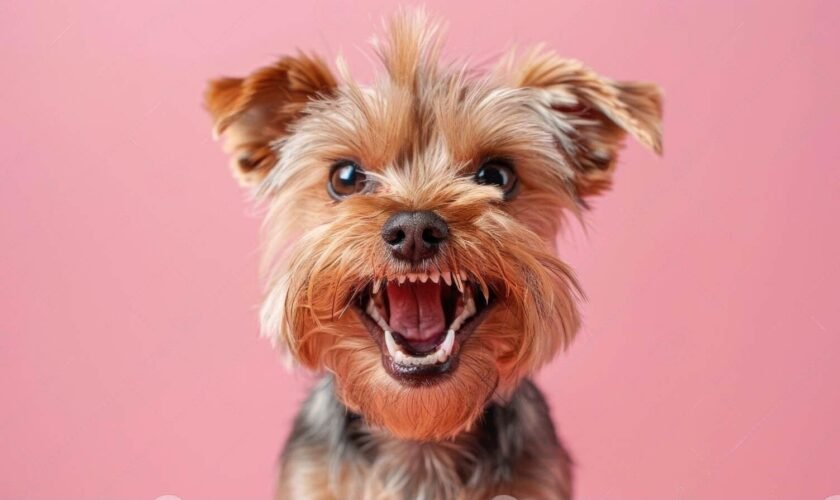
4 Stages of Tooth Decay in Dogs: Protect Your Dog's Health
Did you know that a staggering 80% of dogs show signs of dental disease by the age of three? It's a shocking statistic, and it highlights a widespread problem: neglected canine dental health. More than just bad breath and stained teeth, tooth decay in dogs is a serious issue that can significantly impact their overall well-being. Just like us, dogs need healthy teeth and gums for comfortable eating, joyful play, and an active life. When tooth decay takes hold, it can cause pain, difficulty eating, decreased energy, and even lead to severe health problems affecting the heart, kidneys, and other vital organs.
This blog is designed to guide you through the various dog tooth decay stages, helping you recognize the early warning signs and take preventive action. By the end, you’ll be equipped with the knowledge to protect your dog’s smile—and their health—for years to come.

Stages of Canine Tooth Decay
Tooth decay in dogs, also known as dental caries or cavities (though less common in dogs than periodontal disease), develops over time, progressing through four distinct stages. Each stage poses increasing risks to your dog’s dental and overall health. By understanding these stages, you can take timely action to protect your furry friend’s smile and well-being. It's important to note that while cavities (dental caries) do occur in dogs, periodontal disease, which affects the supporting structures of the teeth, is far more common, affecting a large percentage of adult dogs, as reported by the American Veterinary Dental College (AVDC).
Stage 1: Early Plaque Formation (Reversible)
The journey of tooth decay begins with plaque formation. Microscopic food particles, saliva, and bacteria mix to form a sticky, colorless film called plaque that constantly accumulates on the teeth. While this stage is typically painless, it’s a crucial warning sign of potential problems ahead. You may notice persistent bad breath (halitosis) and subtle discoloration of the teeth near the gum line, often appearing as a thin white or yellowish line. This plaque is soft and can be removed through mechanical means like brushing. The good news? This stage is entirely reversible with consistent and proper dental care. Regular brushing with dog-friendly toothpaste (never human toothpaste, which can be toxic) and providing appropriate dental chews can effectively remove plaque before it mineralizes and hardens into tartar.
💡 Pro Tip: Start a dental care routine early in your dog’s life, ideally during puppyhood. Consistent brushing not only removes plaque but also helps your dog become accustomed to the process, reducing stress during oral care sessions later in life.
Stage 2: Tartar Build-Up (Calculus Formation)
If plaque is not removed within 24-72 hours, it begins to mineralize due to the minerals in saliva, hardening into tartar (also known as calculus). This rough, porous deposit clings stubbornly to the teeth, creating an ideal surface for further bacterial accumulation. Tartar irritates the gums, causing inflammation (gingivitis) and providing a breeding ground for bacteria. At this stage, you’ll likely see visible yellow or brown stains on the teeth, especially along the gum line, and mild gum redness. Unlike plaque, tartar is firmly attached to the tooth enamel and is nearly impossible to remove at home. It requires professional cleaning by a veterinarian or veterinary dentist using specialized instruments. Using tartar-control products like water additives, dental gels, or specially formulated dental diets can help slow down further buildup and support ongoing dental health, but they won't remove existing tartar.
💡 Pro Tip: Schedule regular professional dental cleanings, especially if you notice tartar buildup. These cleanings not only remove hardened deposits but also allow your veterinarian to perform a thorough oral exam and check for early signs of dental disease, including probing the gum pockets to assess gum health.
Stage 3: Gum Inflammation (Gingivitis) (Potentially Reversible)
When tartar is left untreated, the ongoing irritation leads to gingivitis—an inflammation of the gums. This stage is more serious, as it involves noticeable pain and discomfort for your dog. Symptoms include bleeding gums during chewing or brushing, significantly worsening bad breath, and swollen, red, and sensitive gums. The gum line may appear puffy. Gingivitis can also affect your dog’s appetite due to the pain it causes while eating. At this stage, the damage is still potentially reversible with professional cleaning and diligent home care. However, if left unchecked, gingivitis will progress to periodontitis. Immediate professional veterinary care is crucial to treat gingivitis and prevent its progression to more severe stages. After professional treatment, maintaining a strict at-home care routine becomes even more critical.
💡 Pro Tip: Use vet-recommended dental wipes or gels for daily care after professional treatment. These products can be helpful for maintaining gum health, especially in areas that are difficult to reach with a toothbrush. Chlorhexidine-based products can be particularly effective but should be used as directed by your veterinarian.
Stage 4: Advanced Tooth Decay/Periodontal Disease (Periodontitis) (Irreversible)
The final and most severe stage of tooth decay/periodontal disease, periodontitis, occurs when the infection spreads deep into the gums, destroying the supporting structures of the teeth, including the periodontal ligament and alveolar bone. This damage is irreversible. Loose or missing teeth, pus discharge around the gums, receding gums (exposing the tooth roots), and refusal to eat hard foods are common signs. The dog may also experience facial swelling or develop oronasal fistulas (holes between the mouth and nasal cavity). Left untreated, bacteria from the infected gums can enter the bloodstream, leading to systemic health problems such as heart, kidney, and liver disease. Advanced treatments like tooth extraction, periodontal surgery (e.g., bone grafting), or even antibiotics may be necessary to manage this stage and alleviate pain.
💡 Pro Tip: If your dog shows any signs of periodontitis, seek veterinary care immediately. Delaying treatment not only causes significant pain and suffering for your dog but can also lead to serious, potentially life-threatening complications.
Common Signs of Tooth Decay in Dogs
Oral health problems in dogs frequently remain undetected until they reach an advanced stage. Tooth decay is a progressive condition that starts with subtle signs, which can escalate into serious health problems if left untreated. Recognizing these signs early is crucial for maintaining your dog’s dental health and overall well-being. Below are some of the most common symptoms that indicate your dog may be dealing with tooth decay.
1. Persistent Bad Breath
While occasional bad breath is normal, a consistent foul odor from your dog’s mouth can be a red flag. Bad breath, or halitosis, is often caused by the buildup of bacteria on the teeth and gums, signaling the early stages of tooth decay.
2. Difficulty Eating or Chewing
If your dog is avoiding hard foods, eating slowly, or dropping food while chewing, it could indicate pain caused by tooth decay. Advanced stages of decay, such as gum inflammation or loose teeth, can make eating uncomfortable or even painful.
3. Pawing at the Mouth or Unusual Drooling
Dogs may paw at their mouth or drool excessively when they experience dental discomfort. These behaviors are often attempts to alleviate pain caused by toothaches, gum disease, or other oral issues.
4. Visible Discoloration or Buildup on Teeth
Discoloration, yellowing, or brown tartar buildup on the teeth is a clear sign of poor dental hygiene. These deposits can harden and lead to gum inflammation or infection if not addressed promptly.


Preventing Tooth Decay: Essential Care Tips
Preventing tooth decay in dogs is easier than treating its consequences. With a proactive approach that combines proper hygiene, a balanced diet, and regular veterinary care, you can protect your dog’s teeth and gums from harmful decay. Here’s how to create a strong foundation for your dog’s dental health.
1. Daily Oral Hygiene
Maintaining a daily oral care routine is the most effective way to prevent plaque buildup, which is the root cause of tooth decay. Brushing your dog’s teeth with vet-approved toothpaste is essential, as human toothpaste can be toxic to pets. Use a soft-bristled toothbrush designed for dogs, or opt for a finger brush for better control. If brushing isn’t possible, introduce dental wipes or gels that clean the teeth and gums without water. These alternatives are easy to use and can significantly reduce bacteria in your dog’s mouth.
💡 Pro Tip: Begin dental hygiene routines when your dog is a puppy to make them comfortable with the process early on.
2. Healthy Diet Choices
A dog’s diet plays a significant role in their dental health. Crunchy kibbles and specially formulated dental treats can help scrape plaque off the teeth as your dog chews. Avoid sugary or sticky foods, as they can adhere to the teeth and accelerate decay. Additionally, raw vegetables like carrots and apples (in moderation) can act as natural teeth cleaners and are a healthy snack alternative.
💡 Pro Tip: Look for dog foods labeled "dental formula" or those approved by the Veterinary Oral Health Council (VOHC) for added protection against tooth decay.
3. Regular Vet Check-Ups
Annual dental exams and cleanings by a veterinarian are essential for maintaining oral health. A vet can detect early signs of tooth decay that might go unnoticed at home, such as tartar buildup below the gumline or minor gum inflammation. Professional cleanings remove hardened tartar, preventing it from causing gum disease or tooth loss. Early detection also saves you money by avoiding costly procedures like tooth extractions or treatments for severe periodontal disease.
💡 Pro Tip: Schedule a dental check-up at least once a year, or more frequently if your dog is prone to dental issues.
4. Chew Toys and Natural Remedies
Chew toys are an excellent way to keep your dog entertained while promoting dental health. Look for toys specifically designed to clean teeth and massage gums, such as rubber or nylon chews with textured surfaces. Natural options, like raw bones or antlers, can also help reduce tartar buildup, but these should only be given under veterinary supervision to avoid choking or tooth fractures.
💡 Pro Tip: Rotate different types of chew toys to keep your dog engaged and maximize their dental benefits.
When to See a Veterinarian
While regular dental care at home can prevent many issues, certain signs should never be ignored, as they may indicate advanced tooth decay or other serious oral health problems. Swelling around the mouth, gums, or jaw can point to an abscess or deep infection that requires immediate veterinary attention. Persistent bleeding, noticeable pain during eating, or refusal to let you touch their mouth are clear indicators of discomfort that shouldn’t be overlooked. Additionally, a sudden loss of appetite or weight may signal that chewing has become too painful, potentially impacting your dog’s overall health. If you observe any of these symptoms, schedule a visit to your veterinarian promptly to prevent further complications and ensure your dog receives appropriate treatment.
💡 Pro Tip: Early intervention can save your dog from unnecessary pain and reduce the need for expensive treatments. Regular check-ups help catch issues before they escalate.
How Dental Disease Affects Your Dog's Overall Health
The connection between a dog's oral health and their overall well-being extends far beyond just their mouth. Untreated dental disease, particularly periodontitis, creates a gateway for bacteria to enter the bloodstream. These bacteria, originating from the infected gums, can travel to various organs and cause significant health problems. One of the most concerning links is between periodontal disease and heart disease. Studies have shown a correlation between oral bacteria and the development of endocarditis, an inflammation of the heart's inner lining or valves. These bacteria can attach to the heart valves, causing damage and potentially leading to heart failure. Similarly, the kidneys can be affected by the constant exposure to circulating bacteria. The kidneys' role in filtering waste from the blood can be compromised by the inflammation triggered by these bacteria, potentially contributing to kidney disease. In severe cases, the liver, lungs, and even the brain can be impacted by the spread of oral bacteria. This systemic inflammation can exacerbate existing conditions or create new health challenges, highlighting the critical importance of proactive dental care for a dog's overall health.
Why Dental X-rays are Crucial for Your Dog's Dental Health
While a visual examination of your dog's teeth is an important part of a dental check-up, it only tells part of the story. Approximately 60% of a tooth's structure lies below the gum line, hidden from view. This is where dental X-rays, also known as dental radiographs, become invaluable. Dental X-rays provide a detailed view of the tooth roots, jawbone, and surrounding structures. They can reveal hidden problems such as:
Bone loss: A key indicator of periodontitis progression.
Abscesses: Infections at the root of the tooth.
Fractured roots: Often caused by chewing on hard objects or trauma.
Impacted teeth: Teeth that haven't erupted properly.
Tumors or other abnormalities: Within the jaw or surrounding tissues.
By identifying these hidden issues, veterinarians can create a more accurate diagnosis and develop a tailored treatment plan. Dental X-rays are typically performed under anesthesia during a professional dental cleaning, ensuring the dog's comfort and allowing for precise imaging. This technology is crucial for comprehensive dental care and helps prevent more serious complications down the line.
Dog Dental Cleaning Options: At-Home vs. Professional
Maintaining your dog's dental health involves a multi-faceted approach, with different cleaning methods offering varying levels of effectiveness and addressing different needs. Choosing the right approach depends on your dog's individual needs and the severity of any existing dental issues. The following table compares the key aspects of at-home care, professional cleanings (with anesthesia), and anesthesia-free cleanings to help you make informed decisions about your dog's oral health.
Feature
At-Home Care (Brushing, etc.)
Professional Cleaning (with Anesthesia)
Anesthesia-Free Cleaning
Target
Plaque removal/Prevention
Tartar removal (above & below gum line), Comprehensive exam
Primarily visible tartar above gum line
Effectiveness
High (for plaque prevention)
Very High
Low (limited cleaning)
Scope
Surface cleaning
Complete cleaning, X-rays, treatment of dental disease
Primarily cosmetic
Anesthesia Required
No
Yes
No
Cost
Low
Moderate to High
Low to Moderate
Veterinarian Recommended
Yes
Yes
Generally No
Addresses Gum Disease
Prevents early stages
Treats and prevents progression
Does not address subgingival disease
Potential Risks
Gum irritation if done incorrectly
Risks associated with anesthesia (generally low in healthy animals)
Injury to dog if they move, masking of underlying disease
Explanatory Paragraphs Following the Table:
As the table illustrates, at-home care is essential for preventing plaque buildup and maintaining good oral hygiene between professional cleanings. Daily brushing, along with dental chews and appropriate diet, plays a critical role in keeping your dog’s mouth healthy. However, it’s important to recognize the limitations of at-home care. Once plaque hardens into tartar, professional intervention is necessary.
Professional dental cleanings performed by a veterinarian under anesthesia remain the gold standard for canine dental care. These cleanings allow for a thorough examination, including dental X-rays to assess the health of the tooth roots and surrounding bone. This comprehensive approach ensures that any underlying dental issues are identified and treated effectively. While anesthesia carries some inherent risks, these are generally minimal in healthy animals and are significantly outweighed by the benefits of a complete and safe cleaning.
Anesthesia-free dental cleanings, while seemingly convenient and cost-effective, primarily focus on the cosmetic removal of visible tartar above the gum line. They do not address the crucial subgingival cleaning, which is essential for preventing and treating periodontal disease. Furthermore, the lack of anesthesia makes it difficult to perform a thorough oral exam and can put the dog at risk of injury if they move during the procedure. For these reasons, most veterinary dental specialists strongly advise against anesthesia-free dental cleanings.
The High Cost of Neglecting Your Dog's Dental Health
Neglecting your dog's dental health can lead to severe long-term consequences, both medically and financially. Untreated tooth decay often progresses to periodontal disease, causing chronic pain, tooth loss, and systemic infections. Bacteria from infected gums can enter the bloodstream, potentially leading to serious conditions such as liver and kidney diseases.
Financially, the costs of addressing advanced dental issues far exceed those of preventive care. While routine dental cleanings may range from $300 to $2,000, depending on various factors, treatments for severe conditions are significantly more expensive. For instance, tooth extractions can cost between $500 and $2,500, varying with the complexity of the procedure.
Moreover, if infections spread to vital organs, additional treatments and hospitalizations can escalate expenses further. Investing in regular dental care and early intervention not only safeguards your dog's health but also helps avoid substantial veterinary bills in the future.
Our Related article about
Dog Have Arthritis
Conclusion
Understanding the stages of tooth decay in dogs is essential for ensuring their health and happiness. By recognizing early signs like bad breath or tartar buildup, you can take timely action to prevent painful conditions like gingivitis and periodontitis. Proactively managing your dog’s dental care not only prevents serious complications but also improves their overall quality of life.
Taking simple steps—like brushing your dog’s teeth regularly, offering dental-friendly treats, and scheduling routine vet check-ups—can make a significant difference. Don’t wait until symptoms worsen; start a dental care routine today or consult your veterinarian to discuss your dog’s oral health needs.

























































